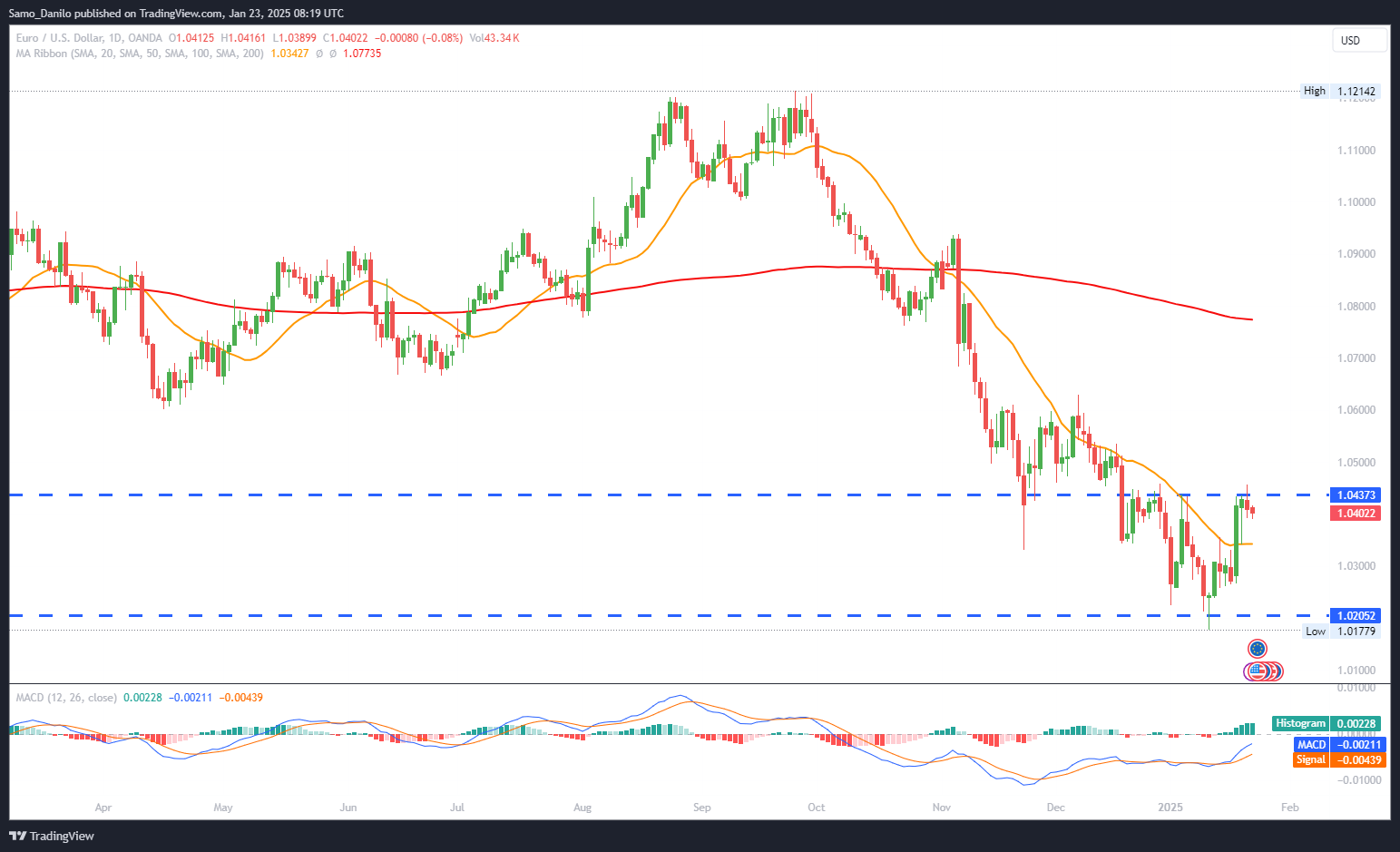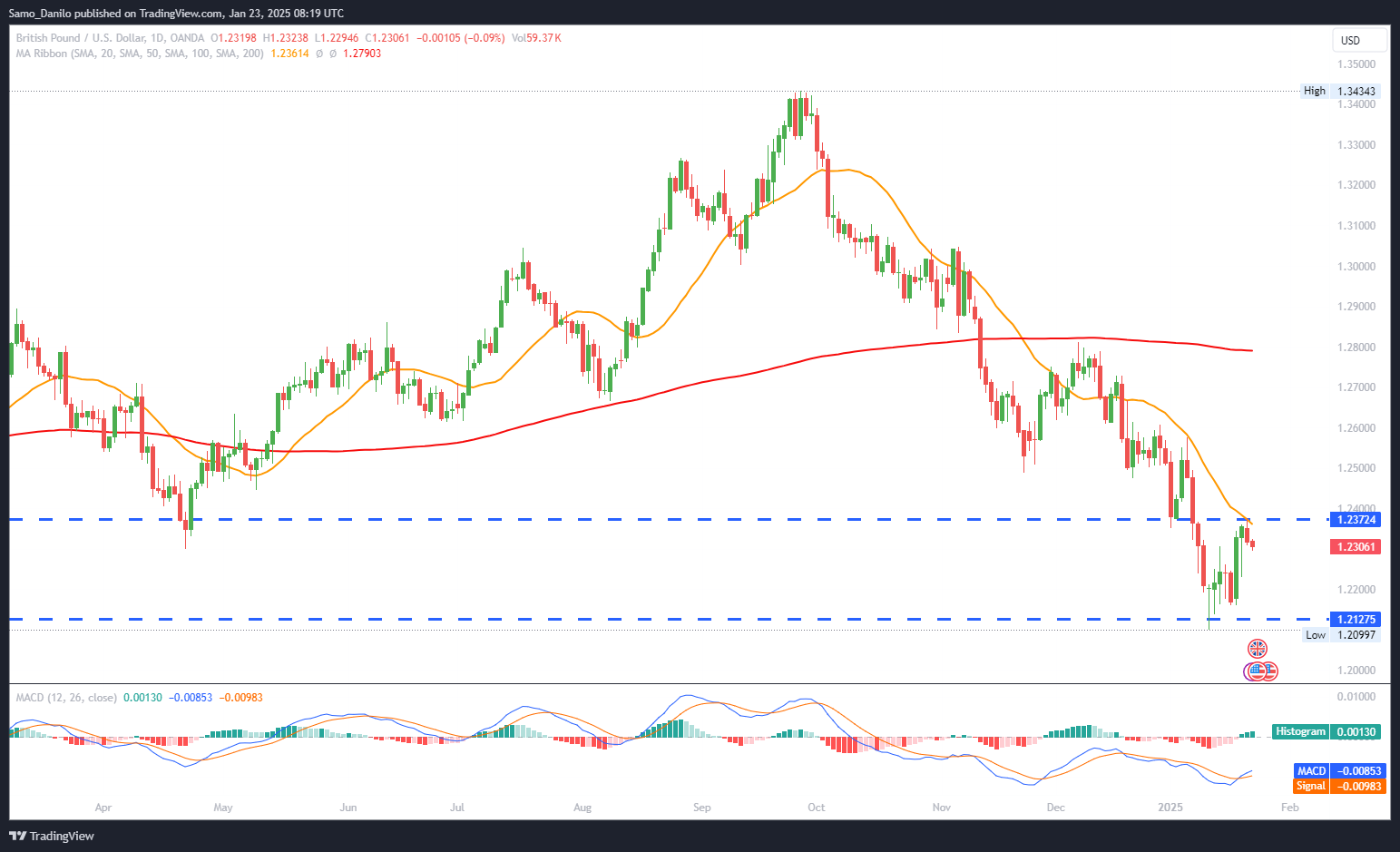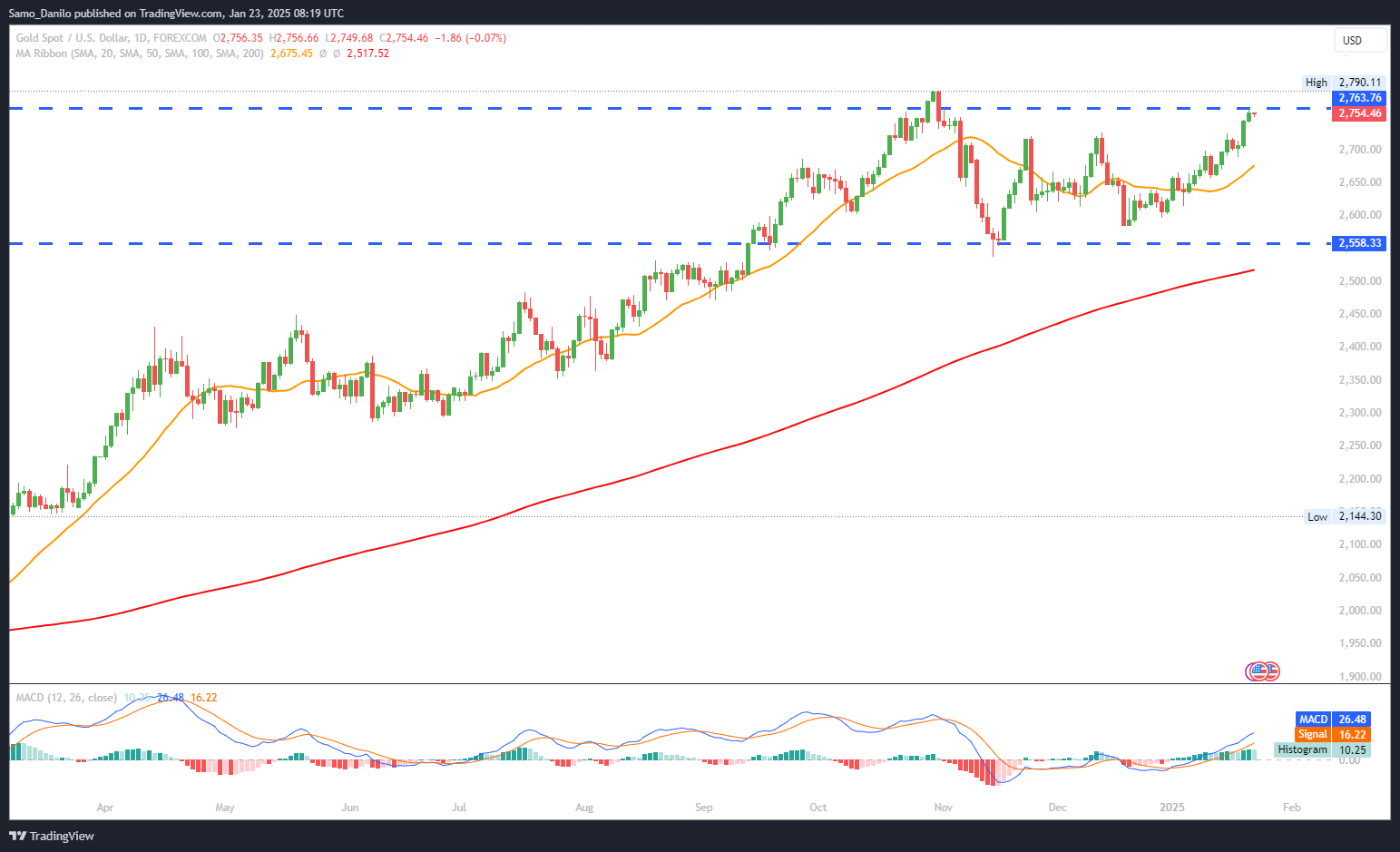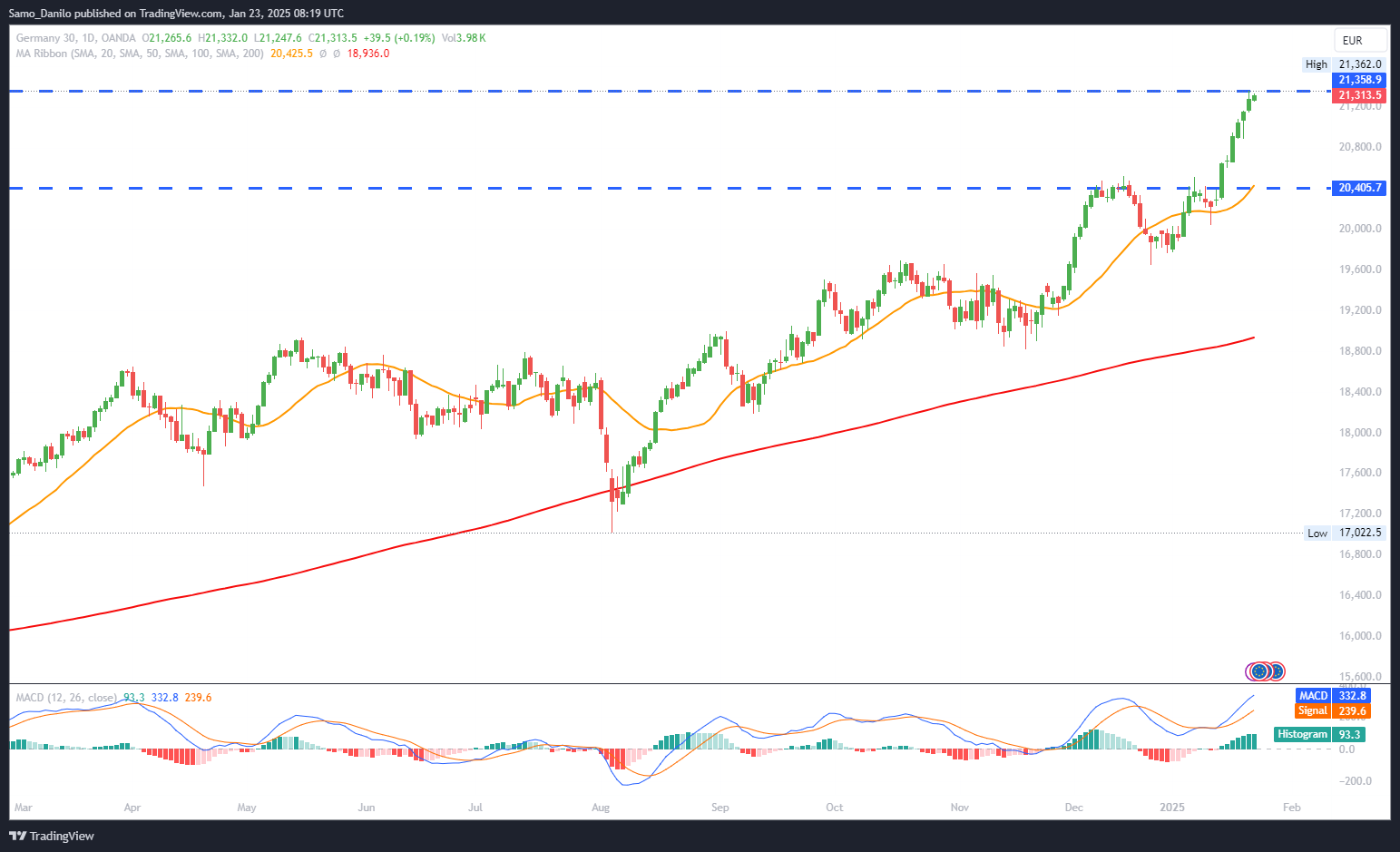EURUSD
- EUR/USD Price: EUR/USD hovers near 1.0400 in early Thursday trading, with the pair under pressure following US President Trump’s threats to impose tariffs on the Eurozone. Concerns over potential trade tensions keep the Euro on the defensive.
- Technical Analysis: The Relative Strength Index (RSI) fell below 60 on Thursday, signaling a loss of bullish momentum. This technical retreat suggests limited upside potential for the pair in the near term unless fresh catalysts emerge.
- ECB Officials: European Central Bank (ECB) President Christine Lagarde and key council members, including Francois Villeroy de Galhau, Klaas Knot, and Yannis Stournaras, all expressed support for additional rate reductions to stimulate economic activity. Market sentiment aligns with expectations of a dovish ECB.
- Inflation Outlook: ECB policymaker Boris Vujcic reiterated that market projections for rate cuts are justified, emphasizing that risks to the inflation outlook remain balanced. His comments further reinforce expectations for continued monetary easing in the Eurozone.
- Data Ahead: Later on Thursday, the preliminary Eurozone Consumer Confidence Index for January will be released. This data will provide further insights into consumer sentiment across the region and could influence EUR/USD dynamics.
Closing statement: EUR/USD faces challenges from both technical and fundamental factors, including trade tensions and dovish ECB rhetoric. Traders should watch the 1.0400 level and remain attentive to Eurozone Consumer Confidence data for directional cues, while monitoring further developments on potential US tariffs.
GBPUSD
- GBP/USD Price: GBP/USD remains steady above 1.2300 during Thursday’s European session, oscillating in a narrow range as the US Dollar finds stability. The pair shows little directional momentum ahead of key data releases.
- Technical Analysis: Price action has established solid technical support near the 1.2200 region, providing a cushion against downside risks. However, the descending 50-day Exponential Moving Average (EMA) around 1.2500 acts as a significant resistance, limiting bullish developments.
- UK Economic Data: The British Pound continues to face headwinds due to disappointing December inflation and retail sales data, subdued labor demand through November, and modest GDP growth. These factors weigh on the outlook for the UK economy and the Pound’s performance.
- BoE Rate Cut: Investors widely anticipate the Bank of England (BoE) to lower its main interest rate by 25 basis points to 4.5% on February 6. Additionally, economists predict up to three further cuts this year, aligning with market expectations for further easing after February.
- PMI Data: Traders are looking ahead to Friday's preliminary S&P Global Purchasing Managers Index (PMI) readings for January, covering both the United Kingdom and the United States. These reports will likely provide fresh insights into economic activity and influence GBP/USD’s trajectory.
Closing statement: GBP/USD remains range-bound, with upside capped by technical resistance and downside supported by key levels. The pair’s movement will hinge on upcoming PMI data and further signals from the Bank of England regarding its monetary policy path. Traders should remain cautious amid mixed economic signals.
XAUUSD
- Gold Price: Gold prices pull back from a three-month high as US Treasury bond yields rise, and the US Dollar gains momentum. However, the retreat is relatively modest as market participants weigh broader risk sentiment.
- Trump’s Tariff Plans: US President Trump’s proposed tariffs—25% on Mexico and Canada and 10% on China—are expected to face opposition from congressional Republicans. The plan to allocate tariff revenues to fund government programs and tax cuts adds uncertainty to the political and economic landscape, influencing market sentiment.
- Chinese Optimism: Renewed optimism in Chinese equity markets, following supportive measures from the China Securities Regulatory Commission (CSRC), limits the downside for gold. China, the largest gold consumer globally, remains a key influence on the precious metal’s demand dynamics.
- US Economic Data: Gold traders anticipate high-impact US economic data releases on Thursday, which could provide new insights into the Federal Reserve’s monetary policy. The data will be pivotal in shaping expectations around the Fed’s potential interest rate cuts this year.
- Fed Rate Cuts: Markets currently anticipate 37 basis points of easing from the Federal Reserve in 2025, with the first rate cut not fully priced in until July, according to LSEG data. This dovish outlook continues to support gold’s appeal as a hedge against economic uncertainty.
Closing statement: Gold prices face near-term pressure from stronger bond yields and the US Dollar but are supported by Chinese market optimism and expectations of Fed rate cuts. The metal’s direction will depend on upcoming US economic data and its implications for monetary policy. Caution is advised as markets digest evolving political and economic developments.
CRUDE OIL
- WTI Price: West Texas Intermediate (WTI) crude oil prices continue to decline, trading near $75.00 per barrel during European trading hours on Wednesday. This marks the fifth consecutive session of losses as markets react to ongoing geopolitical and economic developments.
- Trump’s Tariff Proposals: US President Donald Trump reiterated plans for a 10% tariff on imports from China, the world’s largest crude oil importer. The potential impact on Chinese oil demand weighs heavily on market sentiment, adding downward pressure to global oil prices.
- Tariff Proposal for Canada: Trump’s proposed 25% tariff on Canadian crude oil imports has introduced a potential bullish factor. As Canada exports nearly all its crude oil to the United States, this measure could create upward price pressure by limiting supply options in the US market.
- Energy Policies: The market is also evaluating Trump’s promises to boost oil production, including streamlining permitting processes, expanding drilling acreage, and reversing clean energy policies. While these measures could increase US supply, they raise long-term concerns about global energy market stability.
- Winter Storms: Severe winter weather in the US Gulf Coast has disrupted oil production. North Dakota alone reported a reduction in output of 130,000 to 160,000 barrels per day (bpd), highlighting the vulnerability of supply chains to extreme weather events.
Closing statement: WTI crude oil prices remain under pressure amid Trump’s tariff threats and concerns over global demand. However, proposed tariffs on Canadian crude and weather-related supply disruptions could lend temporary support. Market participants should monitor US-China developments and production data for further cues on oil price direction.
DAX
- DAX Price: After setting a new record of nearly 21,331 points on Wednesday, the DAX shows no signs of immediate weakness but is unlikely to break further records for now. The index remains supported by strong market sentiment and resilience in key sectors.
- Corporate Developments: Deutsche Post’s wage negotiations with the Verdi union continue after an initial round of talks failed to produce results. Meanwhile, Volkswagen has drawn attention after slightly lowering its profit forecast for the core VW brand, potentially impacting sentiment in the auto sector.
- ECB Rate Expectations: ECB policymaker Boris Vujcic noted that market expectations for European Central Bank interest rate cuts are reasonable, with inflation risks balanced. This has bolstered investor confidence in Eurozone equities, providing tailwinds for the DAX.
- AI Investment Plans: New US President Donald Trump’s investment plans in artificial intelligence (AI) have generated optimism across global markets. Additionally, strong earnings reports from major companies such as Adidas and Netflix have reinforced bullish sentiment.
- Davos Forum: Investors will closely watch Trump’s digital address at the World Economic Forum in Davos on Thursday. Any policy announcements or international economic developments could impact market direction in the coming sessions.
Closing statement: The DAX remains stable near record highs, supported by strong corporate earnings, AI investment optimism, and balanced ECB policy expectations. Key risks include ongoing wage talks and Volkswagen’s cautious profit outlook. Investors should monitor Trump’s Davos address and corporate developments for further market cues.




